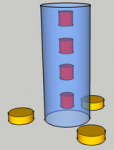I'm trying to measure the distance between two devices, normally, I would use an ultrasonic pair or similar but my situation is this.
I have 10 objects that I need to locate in a 3D plane. I want to use 3 receivers or similar to triangulate the 3D position of each object, each of which can be emitting some sort of wave/ signal. The range is about 0.1m to 1.5m, and I would like the accuracy to be within a few cm.
An ultrasonic pair simply hits an object and bounces back, but as I have 10 (which are not visible i.e. walls / material obstructing view) it is impossible to use infrared or 'line of sight' communication.
Any ideas on what technology, if any, can be used to determine the distance between two electronic circuits (ignore the '10' figure for now)?
Maybe measuring signal strength could be one approach; this may be in-accurate, especially with an unknown number of obstacles in the way.
Thank you in advance
I have 10 objects that I need to locate in a 3D plane. I want to use 3 receivers or similar to triangulate the 3D position of each object, each of which can be emitting some sort of wave/ signal. The range is about 0.1m to 1.5m, and I would like the accuracy to be within a few cm.
An ultrasonic pair simply hits an object and bounces back, but as I have 10 (which are not visible i.e. walls / material obstructing view) it is impossible to use infrared or 'line of sight' communication.
Any ideas on what technology, if any, can be used to determine the distance between two electronic circuits (ignore the '10' figure for now)?
Maybe measuring signal strength could be one approach; this may be in-accurate, especially with an unknown number of obstacles in the way.
Thank you in advance
Last edited:

